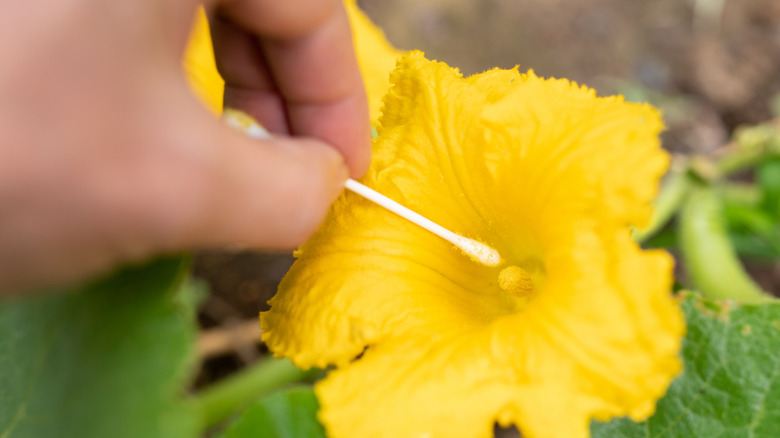Remember This Q-Tip Trick When Growing Squash In The Garden
Summer squash (Cucurbita pepo) can be a wonderful addition to all vegetable gardens. It produces a lot of squash in the right conditions, but it also might need your help to do so. Did you know that the simple Q-tip, a common medicine cabinet staple, can help ensure a bumper crop of summer squash plants?
Summer squash, of course, is harvested in the summer (winter squash is typically harvested in the fall). Summer squash includes several varieties like zucchini, crookneck squash, and straightneck squash. Most squash plants are great producers, but you'll only get mature vegetables if the plants get help with pollination. That's because they have distinctly male flowers and female flowers, which only hang around for a few days, and do not pollinate themselves. If your plant is losing female flowers or the vegetables aren't maturing, then they may not be getting properly pollinated. No worries, there are plenty of tips out there about how to keep summer squash from losing blooms and not producing squash.
One way to make sure your plant produces squash is to encourage pollinators to visit your garden. The squash plant relies on bumblebees or other pollinating insects to hop from its male flowers to its female ones, making sure the vegetables properly mature. But if your squash is planted in a windy spot, or if your bee population is down, then you — and your Q-tips — might need to come to the rescue.
How to use a Q-tip to pollinate your squash flowers
The cotton swab pollination method is easy and it will help the blooms complete the life cycle of the squash plant. First, identify your male and female summer squash flowers. Male and female flowers bloom a pretty yellow and look nearly identical, but you can tell them apart. Male blooms blossom at the end of long green stems, while female flowers blossom at the end of a small vegetable, usually closer to the ground.
To pollinate your flowers, just rub a clean cotton swab inside a male flower, gathering up pollen. You should see the yellow dust clinging to the edge of the white cotton swab. Then, dab the swab into the center of the female flower. One downside to using a Q-tip is that some of the pollen can get trapped on it. If you find that your cotton swabs are a little too sticky, and the transfer isn't working as well as you'd like, you also can try using a paintbrush. Or you can pluck the male flower from its stem and use it to directly apply the pollen to the center of the female flower.
If your plant lacks female blooms, this could be a result of hotter weather, since female flower general like cooler temperatures and male flowers like warmer ones. A lack of female flowers also could be a sign that there might be too much nitrogen in the soil, so be careful when fertilizing your squash plants.
